
Eschscholzia californica, the California poppy, golden poppy, California sunlight or cup of gold, is a species of flowering plant in the family Papaveraceae, native to the United States and Mexico. It is cultivated as an ornamental plant flowering in summer, with showy cup-shaped flowers in brilliant shades of red, orange and yellow. It is also used as food or a garnish. It became the official state flower of California in 1903.
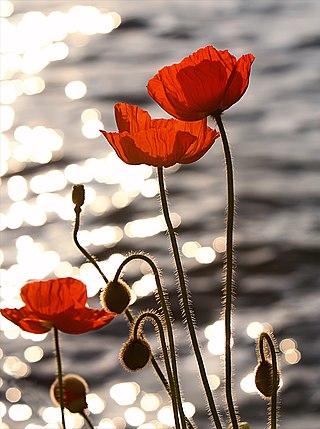
A poppy is a flowering plant in the subfamily Papaveroideae of the family Papaveraceae. Poppies are herbaceous plants, often grown for their colourful flowers. One species of poppy, Papaver somniferum, is the source of the narcotic drug mixture opium which contains powerful medicinal alkaloids such as morphine and has been used since ancient times as an analgesic and narcotic medicinal and recreational drug. It also produces edible seeds. Following the trench warfare in the poppy fields of Flanders, Belgium during World War I, poppies have become a symbol of remembrance of soldiers who have died during wartime, especially in the UK, Canada, Australia, New Zealand and other Commonwealth realms.

Papaver rhoeas, with common names including common poppy, corn poppy, corn rose, field poppy, Flanders poppy, and red poppy, is an annual herbaceous species of flowering plant in the poppy family Papaveraceae. It is a temperate native with a very wide distribution area, from Africa to temperate and tropical Asia and Europe.
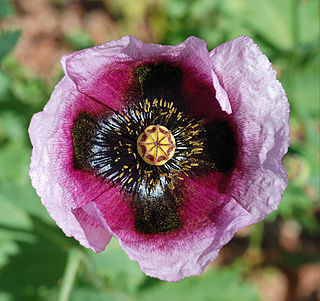
Papaver is a genus of 70–100 species of frost-tolerant annuals, biennials, and perennials native to temperate and cold regions of Eurasia, Africa and North America. It is the type genus of the poppy family, Papaveraceae.

The Papaveraceae are an economically important family of about 42 genera and approximately 775 known species of flowering plants in the order Ranunculales, informally known as the poppy family. The family is cosmopolitan, occurring in temperate and subtropical climates, but almost unknown in the tropics. Most are herbaceous plants, but a few are shrubs and small trees. The family currently includes two groups that have been considered to be separate families: Fumariaceae and Pteridophyllaceae.

Papaver somniferum, commonly known as the opium poppy or breadseed poppy, is a species of flowering plant in the family Papaveraceae. It is the species of plant from which both opium and poppy seeds are derived and is also a valuable ornamental plant grown in gardens. Its native range was east of the Mediterranean Sea, but now is obscured by ancient introductions and cultivation, being naturalized across much of Europe and Asia.
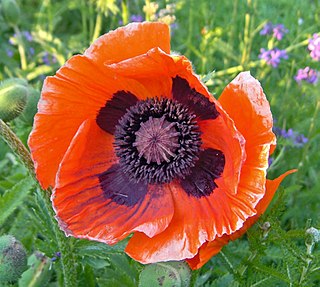
Papaver orientale, the Oriental poppy, is a perennial flowering plant native to the Caucasus, northeastern Turkey, and northern Iran.
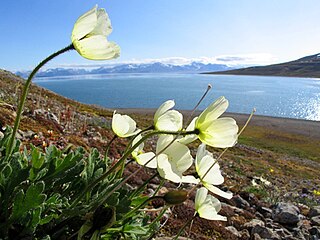
Papaver dahlianum, commonly called the Svalbard poppy, is a poppy species common on Svalbard, north-eastern Greenland and a small area of northern Norway. It is the symbolic flower of Svalbard. Some sources regard this species as part of Papaver radicatum.
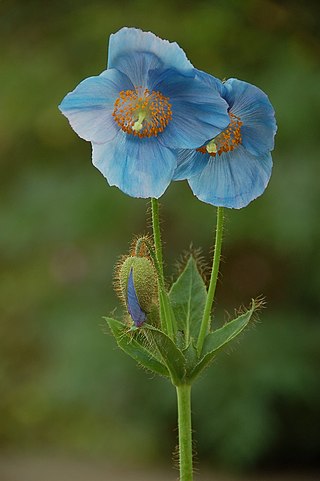
Meconopsis is a genus of flowering plants in the poppy family Papaveraceae. It was created by French botanist Viguier in 1814 for the species known by the common name Welsh poppy, which Carl Linnaeus had described as Papaver cambricum. The genus name means "poppy-like". Himalayan species discovered later were also placed in Meconopsis. In the 21st century, it was discovered that the Himalayan species were less closely related to the Welsh poppy, which has been restored to Papaver. All species now placed in Meconopsis are native to the Himalayas and surrounding regions. They have attractive, usually blue flowers.

Papaver cambricum, synonym Meconopsis cambrica, the Welsh poppy, is a perennial flowering plant in the poppy family Papaveraceae. It has yellow to orange flowers and is widely grown as a garden plant. It is a native of damp, rocky sites in upland areas of Western Europe from the British Isles to the Iberian Peninsula. It has been used since 2006 as the basis for the logo of the political party Plaid Cymru.

Papaver nudicaule, the Iceland poppy, is a boreal flowering plant. Native to subpolar regions of Asia and North America, and the mountains of Central Asia as well as temperate China, Iceland poppies are hardy but short-lived perennials, often grown as biennials. They yield large, papery, bowl-shaped, lightly fragrant flowers supported by hairy, 1 foot (30 cm) curved stems among feathery blue-green foliage 1-6 inches long. They were first described by botanists in 1759. The wild species blooms in white or yellow, and is hardy from USDA Zones 3a-10b.

Roemeria argemone is a species of flowering plant in the poppy family Papaveraceae. Its common names include long pricklyhead poppy, prickly poppy and pale poppy. Its native range includes parts of Eurasia and North Africa, but it can be found growing wild in parts of North America, where it is an introduced species. It is cultivated as an ornamental plant.

Papaver radicatum is a species of poppy known by the common names Arctic poppy, rooted poppy, and yellow poppy. It is a flowering plant in the family Papaveraceae.

Papaver alpinum, synonym Oreomecon alpina, the Alpine poppy or dwarf poppy, is a poppy found in the Alps. The circumscription of the species varies considerably. In some treatments, the species is one of a group of related species, and includes several subspecies, four of which are found in Austria. In other treatments, it includes species that have been treated as separate, and has at most one subspecies.

Papaver glaucum, the tulip poppy, Turkish tulip or Turkish red poppy, is a poppy found in the region of Anatolia.

Papaver croceum, common name ice poppy, is a species of flowering plant in the family Papaveraceae.
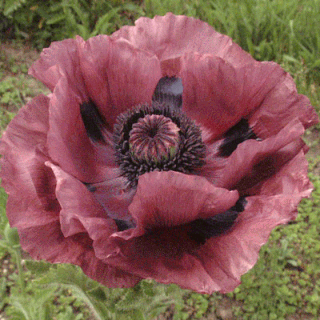
Papaver orientale 'Patty's Plum' is a poppy originally discovered growing in a compost heap at Kingsdon Nursery Garden, Somerset, UK, by Sandra Pope of Hadspen House, Somerset, UK, who had come to work in Mrs Patricia Marrow's garden. After the damson colour of the poppy was noticed, Marrow propagated it. She and Pope later came up with a name "Patty's Plum" because that is Marrow's first name, and it is typical of Marrow to describe the colour as "Plum". The cultivar has also been known under the synonym: Papaverorientale 'Mrs Marrow's Plum'.

Papaver degenii, the Pirin poppy, is a poppy endemic to the Pirin Mountains of south-western Bulgaria where it is found at altitudes from 2,100 to 2,900 m. It is included in the Red Book of Bulgaria as vulnerable species. It is considered by some authors to be conspecific with the Alpine poppy.
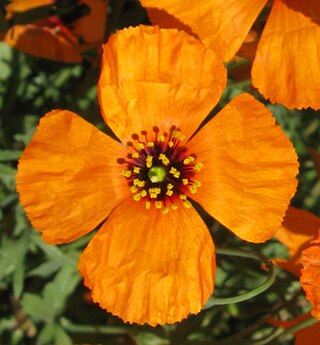
Papaver heterophyllum, previously known as Stylomecon heterophylla, and better known as the wind poppy, is a winter annual herbaceous plant. It is endemic to the western California Floristic Province and known to grow in the area starting from the San Francisco Bay Area of Central Western California southwards to northwestern Baja California, Mexico. Its main habitat is often described as mesic and shady, with loamy soils such as soft sandy loam, clay loam, and leaf mold loam.

Papaver hybridum, the rough poppy or round pricklyhead poppy, is a widespread species of flowering plant in the family Papaveraceae. It is native to the Mediterranean region, and western Asia as far as the western Himalayas, and has been introduced to much of the rest of Europe, South Africa, all of Australia, some US states, Chile and Argentina. It is a minor weed of cereal crops, and its range is expected to greatly expand due to climate change.




















